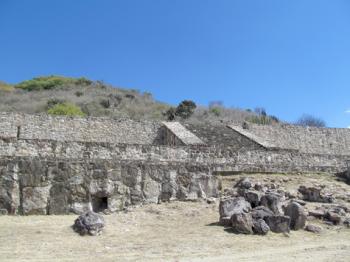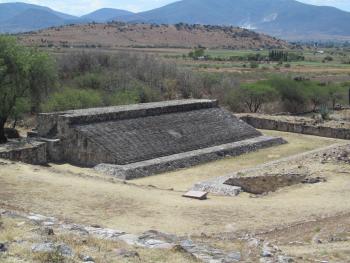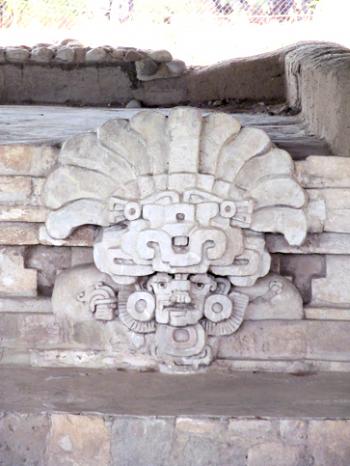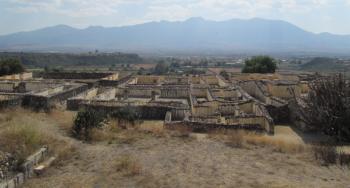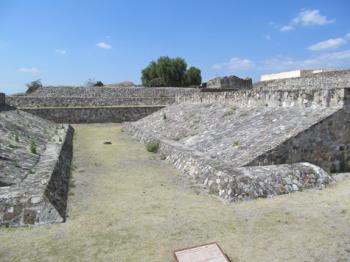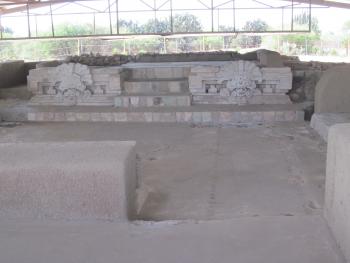A trio of Oaxacan sites
This item appears on page 50 of the January 2020 issue.
The city of Oaxaca lies about 290 miles southeast of Mexico City in an area enclosed by three valleys. In these valleys developed some of the richest cultures of pre-Columbian Mexico: first, the Zapotecs, whose earliest noteworthy archaeological site, San José Mogote, dates from the 7th century BC (perhaps even much earlier, to the 15th century BC), then, much later, the Mixtecs, who probably arrived in the valleys in the 9th and 10th centuries AD.
Two of Mexico’s foremost archaeological sites lie in these valleys: Monte Albán and Mitla, both close to Oaxaca. Monte Albán is Zapotec. Mitla is probably Zapotec in origin but with Mixtec additions (Nov. ’19, pg. 44).
The Tlacolula Valley, where Mitla is located, is rich in other archaeological sites. On our trip in February 2019, it is these relatively unknown sites, along with its better-known neighbors, that my husband, Paul, and I wanted to explore.
Dainzú
Of the sites we visited, the closest to Oaxaca is Dainzú, 14 miles away. Before visiting, however, we wanted to pay our respects to El Tule, a gigantic Montezuma cypress tree in the village of Santa María del Tule en route to Dainzú.
The tree, reputedly over 2,000 years old, towers over the adjacent church. Tourists approach it reverentially as if it were an ancient pre-Hispanic god.
Past El Tule some 6 miles is Dainzú, just off highway 190 along a dirt road. This Zapotec site enjoyed a long life of over 1,800 years, from its beginning about 600 BC to its abandonment around AD 1250.
What is visible today is only a small portion of what was once a sizable city that reached its apogee from AD 250 to 350, though dates are debatable. The main building, called Building A, with a grand central staircase, gives an idea of how important Dainzú once must have been. Bas reliefs decorate the lowest wall of Building A and probably represent ball players. They are difficult to see because of a protective shed covering them.
Across from Building A lie the ruins of buildings, probably residences, constructed around patios. Slightly downhill from these is a ballcourt built in a capital-I shape, similar to those at Monte Albán and at Yagul, which we visited later that day.
Lambityeco
Four miles farther along the highway lies Lambityeco. As at Dainzú, only a small section of this largely unexcavated Zapotec city is visible. The city was called Yegüih and consisted of temples and residences. The part of the city that is labeled Lambityeco was probably the most important of the residential complexes in Yegüih, judging from what has been excavated.
Artifacts found on the site indicate settlement from as early as the 8th century BC, but it was only after AD 600 that Yegüih/Lambityeco grew rapidly, declining just as rapidly after AD 750. Yegüih’s decline and the resulting unrest probably led to the population’s migration to the better-fortified site at nearby Yagul.
Two important structures can be viewed at Lambityeco. Structure 195 was once the residence of the ruler. There’s a courtyard now protected by a metal roof with what could be altars at one end. To me, they looked more like thrones than altars. In front of this is the entrance to an underground tomb.
Adjacent is Structure 190, the residence of the high priest. A modern metal roof protects the Temple of Cocijo, with two monumental masks on either side of a short staircase. Both masks represent Cocijo, one of the principal Zapotec gods. He is associated with lightning and rain.
The masks have headdresses of feathers and large ear spools. They hold lightning bolts in one hand and vessels with water streaming out in the other.
Yagul
Another 4 miles takes visitors to Yagul, the most dramatically situated of the three sites visited. Yagul sits atop a natural terrace overlooking the valley.
Yagul’s origins may stretch back to 3000 BC, when it’s likely that small settlements existed in the area. With the decline of Yegüih, its people sought refuge atop the terrace with the consequent expansion of Yagul.
Apparently, Yagul still existed at the time of the Spanish conquest in the early 16th century. It’s also likely that this site is a composite of earlier Zapotec and later Mixtec influences.
A pathway leads visitors to Patio 4, a large rectangular space surrounded by the remnants of small pyramids. Just beyond is the I-shaped ballcourt, the largest in Oaxaca and the second-largest in Mexico. (Only Chichén Itzá’s ballcourt is larger.)
Adjacent to the ballcourt lies Patio 1, another sizable area but with a long Council Hall dominating one side. The hall is decorated with the fret design that is so characteristic of Mitla. This building was the meeting place and the center of administration of Yagul’s rulers.
A little uphill is Yagul’s most prominent complex, the Palace of the Six Patios, where the city’s rulers lived. The palace consists of patios surrounded by one-story plastered stone buildings with multiple entrances, creating a picturesque maze.
From the palace complex, there’s a panoramic view of the Tlacolula Valley below, where the houses and farms of most of Yagul’s population once were. For an even better view, you can hike up a steep trail to the ruins of the defensive walls that helped protect Yagul.
There are numerous underground tombs that dot the archaeological area, but none were open when we visited.
If you go…
At Yagul, the entry charge was 45 pesos, about $2.25 when we visited. The other two sites did not charge us. The ticket office at Lambityeco was closed, and there was neither a ticket office nor any official to collect fees at Dainzú.
Allow at least half a day to visit all three sites. It is wise not to include Mitla (tempting because it is so close to these three sites), because it deserves a half day on its own. Visiting four archaeological sites on one day is what Paul calls “archaeological overkill,” too much of a good thing.
We hired a private guide/driver for this excursion from Oaxaca, much better we felt than taking a group tour. This way, we could spend as much or as little time as we wanted at each site, plus we were free to add on additional stops, if wanted. Your hotel can help with securing a reliable guide.
If planning a full day’s outing, consider a detour to the village of Teotitlán del Valle on the way back to Oaxaca. The Oaxaca area is one of the best in Mexico for handicrafts, with villages each specializing in one particular craft. Teotitlán del Valle’s specialty is weaving. You can visit individual weavers in their homes or workshops or wander through the community weaving market, where the villagers’ colorful weavings are displayed for sale.
The Oaxaca area is also famed for its markets, one for each day of the week. Southeast of the city on the route to Dainzú, Lambityeco and Yagul, there’s a Monday market at Teotitlán del Valle, a Tuesday market at Santa Ana del Valle and a Sunday market at Tlacolula.
Since we had already visited the weaving village of Teotitlán del Valle, we chose the Sunday Tlacolula market. It was bustling, colorful and full of tempting things to buy. Take lots of pesos. We bought enough weavings to require us to buy an extra duffel bag to get it all home.

